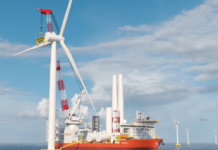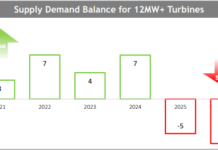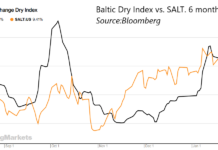When I first got wind (no pun intended) of Finavera Renewables (TSX:FVR or FNVRF.PK), I did not make too much of it because my view was that commercial exploitation of wave power – which is the banner under which Finavera has decided to promote itself to the investor community – was a few years away at best. Then, upon hearing that the company had managed to get a prototype in the water (PDF document), I decided to do a bit more digging. After all, if the technology worked, the economics of the business model would closely resemble those of my uncontested favorite at the moment: wind power. Wave power also had the advantage of being more predictable than wind. With a proven technology, the firm could get itself into power purchase agreements, lever up to take advantage of the relatively lower cost of debt, and go on finding new sites to exploit while its existing operations generated steady cash flows. At some point in the perhaps not-so-distant future, the company could become an acquisition target, and yet more upside could accrue to equity holders. What’s not to like for an investor who is in early? Almost immediately I came across something that truly poked my interest: rights to develop wind assets in Germany, Ireland and the Canadian provinces of Alberta and British Columbia. Granted, there was no big secret here. This information was there all along for anyone who bothered to look. Finavera posted on its website research notes by two Canadian boutique brokerages that cover the stock: Haywood Securities and Dundee Securities (both PDF documents). Both notes confirmed my intuition at the time (this was in late October ’07), namely that the bulk of near-term value rested with the wind projects, not wave energy. Although valuations differed, both reports had a much higher target than the C$0.40 the stock was trading at, and my own experience with renewables-focused Canadian independent power producers (IPPs) told me that they were likely right. I pulled the trigger and went long at C$0.40. Shortly after, things turned ugly. First, Finavera’s device sunk to the bottom of the ocean before tests were completed, compounding fears by environmentalists and fishermen that this idea may spell nothing but disaster for marine life. Second, when Q3 results (PDF document) came out, it became clear that things were a lot worse (PDF document) than just a sunken piece of steel and a few worried anglers: the company had a working capital deficit of C$4.1 million, it had to write down C$6 million in goodwill related to the very technology that had just sunk and on which it was banking its future, and it was abandoning its German wind farm plans, which would have generated much-needed cash in the near term. What’s more, rough conditions in capital markets caused by the credit crunch prevented Finavera from moving forward with a critical round of financing. The stock got killed, flirting with the C$0.10 mark. Ouch…but I hung on. Within a week, Finavera announced that it had secured about C$2 million in financing (down from C$23 million it was initially hoping to raise) and had restructured its board. New board members had weaker cleantech credentials but stronger acumen in financial and business matters. Not exactly great news but I decided to hang on until late December, when I was scheduled to get back from a trip to India – this would give me time to think things through, and it’s not like I’d bet the house on this one anyways. It was while sitting at a small internet cafe after visiting a tea plantation in Kerala that I got the good news: Finavera was at the center of the biggest ocean power news story I could recall. Shortly after, more good news came out related to the firm’s wave power activities. Maybe there was value in wave after all. And this brings us to… The reason why we selected Finavera as our #2 speculative pick for 2008. I still feel that viewed through the lens of a conventional valuation approach, wind is where most of the value lays. There is no doubt, however, that the succession of positive wave-related news has created something of a buzz, as evidenced by the stock rebounding to close at C$0.335 ($0.3371 in the US) on Monday on heavy volumes. Tom and I both agree that the PG&E deal could continue to generate significant investor interest in both wave energy and in Finavera in particular, and that the stock could see some strong upside as a result. I increased my position on Monday and my adjusted cost base now stands at $0.37. More good news on the wave front could spell good things for this stock in 2008. There are, of course, a number of important caveats: (A) Unless anything has changed, the company must still fill a working capital gap of around $C2 million. With 174 million shares outstanding, which is very large relative to sector comps (i.e. small earning-less IPPs), the risk of dilution looms large. On the positive side, the recent recovery in share price is good news from the point of view of seeking financing. (B) Without the German wind farms, no company operation will generate revenue or earnings until 2009 at the earliest, which is assuming that Finavera can secure all the funding it needs to set up its Alberta wind farms. But liquidity is not the only thing in short supply at the moment; the market for wind turbines is currently incredibly tight and small wind farm operators are reportedly having a heck of a time getting their hands on turbines and turbine parts. Personally, I would feel reassured if I saw company management focus on executing on wind first, and worrying about wave once cash is coming through. (C) Finavera wrote down all of the goodwill associated with its 2006 purchase of AquaEnergy (PDF document), which is how it initially got its wave technology. In fact, according to the company’s Q3 2007 filings (PDF document), goodwill associated with the IP for the wave technology (called AquaBuOY) accounted for 97% of the value of all assets acquired in that transaction. While this write-down is more of an accounting formality than an indication that the technology is completely useless, as some may have thought, this still means that there were serious flaws and that Finavera’s engineers must go back to the drawing board. In other words, this is not wind and the technology is far from ready for commercialization. Power purchase agreement or not, if Finavera wants to be a force to be reckoned with in ocean power it will have to have something to show for on the technology side before too long. Not to mention that if it doesn’t soon the market will probably forget all about what just happened with PG&E and move on.
DISCLOSURE: Charles Morand has a long position in TSX:FVR.
DISCLAIMER: The information and trades provided here are for informational purposes only and are not a solicitation to buy or sell any of these securities. Investing involves substantial risk and you should evaluate your own risk levels before you make any investment. Past results are not an indication of future performance. Please take the time to read the full disclaimer here.








don’t care if this is posted or not. pls have the author double check his math on fslr Te costs. i believe he is off a decimal and his $80m should be $8m.
major inaccuracy!!!